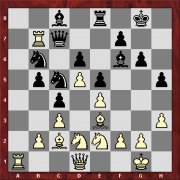 |
Book Reviews |
Last updated 25 July 2004

| index |
Gladiatoren Ante Portas

by Volker-Michael Anton and Fritz Baumbach
Introduction
This is a delightful book, co-authored by GMs Volker-Michael Anton and Dr Fritz Baumbach of Germany. Many of our readers will remember that Volker-M qualified for his GM title in the Scottish Centenary Tournament 1984-88, and Dr Fritz of course was the XI ICCF World Champion 1988-90.
The book has as good a pedigree as the authors, being the tournament record for the Hans-Werner von Massow (ICCF President 1960-87) Memorial Invitation. The event coincided with the 50th Jubilee celebrations of the BdF, the German CC Federation. At the time (1996-2001), this was the strongest-ever CC event, featuring World Champions Umansky (1996) and Timmerman (2001), plus 6 other ex-champions.
Contents
The first thing to notice is the superb production quality of the book - it is hardback (15.5 x 21.5mm), stitch bound, and uses heavier weight reflective paper to give a beautiful look and feel. The black and white layout is sharp throughout.
There are 240 pages containing 105 very high-class games, with 285 diagrams. The book opens with an introduction by Alan Borwell, then ICCF President, a short biography of Hans-Werner von Massow, and a prologue of the event.
Each of the 15 gladiators is profiled with his photograph, family details and chess career. Then we are into the games, studded with GM brilliancies, but also showing that 'to err is human' applies to top-flight players also.
The games are interspersed with nice anecdotes and cartoons. For example, the authors pose (and answer) questions like 'what has the fable of the fox and the raven to do with chess?', 'why must you be careful with computer help?', 'why do new queens not always bring luck?', and 'what was an ex-champion looking for in a rural shop?', thus adding colour to the serious business of making moves. A full event cross-table completes the games, and the book concludes with BdF President Fritz Baumbach's presentation speech to the tiebreak winner Volker-Michael Anton, an extended profile of the victor, and player and opening indices.
German Notation
Games in the book are in German algebraic, so you need to know the letters for the pieces as follows:
| König (K) | King | King (K) |
| Dame (D) | Lady | Queen (Q) |
| Turm (T) | Tower | Rook (R) |
| Läufer (L) | Runner | Bishop (B) |
| Springer (S) | Jumper | Knight (N) |
| Bauer (b) | Peasant | Pawn (p) |
German Commentary
As befits the tournament, the authors, and the biggest CC nation, the book is written in German. This might prove daunting for UK residents, who are notoriously bad at languages, but help is at hand!
Rather than thumb through your phrase book or dictionary, I suggest you try Alta Vista's Babel Fish website and there you will be able to get approximate translations to and from English into all the major world languages.
To illustrate the point, I've given the original German comment followed by the Babel Fish translation in the sample game below. It's very literal and not good English, but it makes enough sense for you to fully enjoy the game.
Sample Game
Here is the game between the world champions at the start and end of the tournament.
| Timmerman, G (2744) - Umansky, M (2633) [C95] von Massow Memorial, 2001 [Notes by Anton, Baumbach & Babel Fish!] | |
| 1.e4 | e5 |
| 2.Nf3 | Nc6 |
| 3.Bb5 | a6 |
| 4.Ba4 | Nf6 |
| 5.0-0 | Be7 |
| 6.Re1 | b5 |
| 7.Bb3 | d6 |
| 8.c3 | 0-0 |
| 9.h3 | Nb8 |
| Wie von Weiß nicht anders erwartet, wählt Umansky die verlässliche Breyer-Variante.
In der Folge entwickelt sich das Spiel entlang bekannter Muster. As does not expect from white differently, Umansky selects the reliable Breyer variant. In the consequence the play develops along well-known samples. | |
| 10.d4 | Nbd7 |
| 11.Nbd2 | Bb7 |
| 12.Bc2 | Re8 |
| 13.Nf1 | Bf8 |
| 14.Ng3 | g6 |
| 15.a4 | c5 |
| 16.d5 | c4 |
| 17.Bg5 | h6 |
| 18.Be3 | Nc5 |
| 19.Qd2 | h5 |
| 20.Bg5 | Be7 |
| 21.Ra3 | Nfd7 |
| 22.Be3 | |
| Damals ein neuer Plan und ehrgeiziger als 22.Lxe7, was in der Partie Tatai gegen Dorfmann,
Budapest 1988 schnell zum Remis führte. So spielt der Läufer auf e3 eine bessere Rolle als sein
Gegenpart auf f6. At that time a new plan and more ambitiously than 22.Bxe7, which led in the game Tatai against Dorfmann, Budapest 1988 fast to the draw. Thus the runner on e3 plays a better role as its counterpart on f6. | |
| 22... | Bf6 |
| 23.Rea1 | Qc7 |
| 24.Qd1 | |
| Weiß beabsichtigt, nach entsprechender Vorbereitung die schwarze Bauernkette mit b2-b3
"anzuknabbern". White intended, after appropriate preparation the black peasant chain with b2-b3 "nibble at". | |
| 24... | Rab8 |
| 25.Nd2 | Bc8 |
| 26.axb5 | axb5 |
| 27.Ne2 | Nb6 |
| 28.Ra7 | Rb7 |
| 29.Rxb7 | |
 | |
| 29... | Qxb7? |
| Hier steht die Dame nicht gut, was sich bald herausstellt. Stattdessen macht die
schwarze Stellung nach 29...Lxb7 durchaus noch einen harmonischen Eindruck und Weiß hätte nur
leichten Vorteil. Here the lady does not stand well, which turns out soon. Instead the black position makes after 29... Bxb7 quite still another a harmonious impression and white would have only light advantage. | |
| 30.b3! | cxb3 |
| 31.Nxb3 | Nca4 |
| Vorzuziehen und wohl das kleinere Übel für Schwarz war 31...Sxb3 32.Lxb3 Ld7. To prefer and the smaller evil for black was probably 31... Nxb3 32.Bxb3 Bd7. | |
| 32.Na5 | Qc7 |
| 33.Bxa4 | Nxa4 |
| Schlecht ist 33...bxa4 34.Tb1 Sc4 35.Sxc4 Dxc4 36.Tb4 mit Gewinn des a-Bauern. Bad is 33... bxa4 34.Rb1 Nc4 35.Nxc4 Qxc4 36.Rb4 with profit of the a-peasant. | |
| 34.Nc6 | Bd7 |
 | |
| 35.c4!! | |
| Dieses kraftvolle Bauernopfer, wonach die weißen Figuren äußerst aktiv werden,
dürfte Schwarz nicht auf der Rechnung gehabt haben. Im höheren Sinne ist das schon der Gewinnzug!. This strong peasant sacrifice, after which the white figures become extremely active, might not have had black on the calculation. In the higher sense that is already the winning move! | |
| 35... | Nb2 |
| Nach 35...Lxc6 36.dxc6 Sb2 (natürlich verliert 36...Dxc6 37.cxb5 Dxb5 38.Txa4 glatt
eine Figur.) 37.Dd5 Sxc4 38.Ta7 Sxe3 39.Da2 Sd5 40.Txc7 Sxc7 wird der mächtige c-Bauer über kurz oder
lang das Schicksal von Schwarz besiegeln. After 35... Bxc6 36.dxc6 Nb2 (naturally 36... Qxc6 37.cxb5 Qxb5 38.Rxa4 lose smoothly a figure.) 37.Qd5 Nxc4 38.Ra7 Nxe3 39.Qa2 Nd5 40.Rxc7 Nxc7 the powerful c-peasant will sooner or later seal the fate of black. | |
| 36.Qb3 | Nxc4 |
| 37.Ra7 | Qc8 |
 | |
| 38.Bh6! | |
| Der Läufer entzieht sich dem drohenden Abtausch und beunruhigt durch sein Auftauchen
den König. Ein grober Fehler wäre der Rückgewinn des Bauern mit 38.Dxb5? gewesen, denn auf
38...Sxe3 39.fxe3 Lxh3! 40.gxh3 Dxh3 hätte Schwarz nur gewartet. Dann greift nämlich der Lf6 kräftig
ins Geschehen ein und das Blatt hat sich total gewendet. The runner extracts itself from the threatening exchange and worries by its emerging by the king. A gross error would be recovers the peasant with 38.Qxb5? because on 38... Nxe3 39.fxe3 Bxh3! 40.gxh3 Qxh3 would have only waited black. Then the Bf6 intervenes strongly in the happening and the sheet totally turned. | |
| 38... | Bd8 |
| Schöne Bilder ergeben sich auch in der Variante 38...Lxc6 39.Df3! Te6 40.Sc3! Kh7
41.Lg5! Kg7 42.dxc6! Dxc6 43.Sd5 und nach Aktivierung der letzten weißen Figur bricht die schwarze
Stellung völlig zusammen. Beautiful pictures result also in the variant 38... Bxc6 39.Qf3! Re6 40.Nc3! Kh7 41.Bg5! Kg7 42.dxc6! Qxc6 43.Nd5 and after activation of the last white figure breaks down the black position completely. | |
| 39.Qf3! | |
| Jetzt nehmen die weißen Drohungen am Königflügel ganz konkrete Formen an, während Schwarz nach dem
weißen Fehlgriff 39.Dxb5? Sa5! 40.Txa5 Lxa5 41.Dxa5 Lxc6 42.dxc6 Dxc6 plötzlich wieder munter mitspielen würde. Now do the white threats at the king wing, during black take completely concrete forms after the white mistake 39.Qxb5? Na5! 40.Rxa5 Bxa5 41.Qxa5 Bxc6 42.dxc6 Qxc6 would along-play suddenly again lively. | |
| 39... | f6 |
| 39...h4 scheitert an 40.Sxd8 Dxd8 41.Txd7! Dxd7 42.Df6 nebst Matt. 39... h4 fails because of 40.Nxd8 Qxd8 41.Rxd7! Qxd7 42.Qf6 together with mate. | |
| 40.Ng3! | Kh7 |
 | |
| 41.Bg5! | |
| Schwarz gab auf und keinesfalls zu früh, was z.B. mit 41.Lg5 Kg7 42.Sxh5+ gxh5 43.Dxh5 Th8
(oder 43...fxg5 44.Dxe8! ) 44.Lh6+! Txh6 45.Dg4+ Tg6 46.Txd7+ Kf8 47.De6! glänzend bewiesen werden kann. Black did not give up under any circumstances too early, which e.g. with 41.Bg5 Kg7 42.Nxh5+ gxh5 43.Qxh5 Rh8 (or 43... fxg5 44.Qxe8!) 44.Bh6+! Rxh6 45.Qg4+ Rg6 46.Rxd7+ Kf8 47.Qe6! sparklingly proves. | |
| 41... | 1-0 |
Conclusion
It took me a while to review this book, but it was worth the wait. Its historical significance makes it a collector's item, but it is also great entertainment for any CC player.
If you can overcome your apprehension about the language, the book will please in all respects. Note that you can opt to take the games CD along with the book, which has the twin advantages of adding some top-class games to your database, and making the copy and paste operation into Babel Fish much easier!!
The superior production quality means that the cover price of 13.80 euros, plus 4.50 euros p&p, is a steal - where else can you get hardback for under £12?! . The accompanying CD database optionally costs a further 5.90 euros.
Further details may be obtained from the special website: Anton-Baumbach through which you can order and pay. If you prefer, payment may be made via Paypal
Finally, thanks to Volker-M for his prompt assistance in sending my review copy. He has fond memories of his participation in our Centenary Tournament, and extends good wishes to all his Scottish friends! On behalf of them, congratulations to you and Fritz (the player, not the computer...) for producing a really excellent publication!